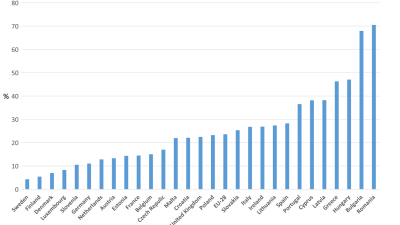Changes in the number of jobless households don't explain very much of the diversity in poverty rates in Europe during the economic upswing prior to 2008, according to a new paper from Eurostat, the EU's statistical body.
The paper examines the distribution of individual jobs between households in EU countries, the link between individual employment rates and household employment rates, and the relationship between employment (at both levels of aggregation) and poverty.
Key points
- Gains in individual employment rates in Europe after 2000 were enhanced by decreasing polarisation of jobs between households – in other words, by a more even distribution of jobs between households – resulting in decreasing 'welfare state dependency'. Experience in the UK suggests that the prevalence of jobless households can be influenced by policy, the paper adds.
- Nonetheless, changes in the share of jobless households cannot explain very much of the diverse changes in national at-risk-of-poverty rates during the economic upswing between 2004-05 and 2007-08. It would therefore be incorrect to attribute disappointing poverty trends during the employment boom years solely to the modest conversion of individual employment successes in household employment successes, or more specifically to ongoing polarisation of jobs between households.
- But that does not diminish, say the paper's authors, the importance policy-makers should attach to reducing the number of people living in low work-intensity households. The aim of doing so, which is part of the multi-dimensional Europe 2020 target on social exclusion and poverty, continues to be justified. Policies to promote economic growth and employment creation should be complemented by policies to reduce poverty through social transfers and inclusive labour market policies.
Source: Vincent Corluy and Frank Vandenbroucke, Individual Employment, Household Employment and Risk of Poverty in the EU: A Decomposition Analysis – 2013 Edition, Eurostat (European Union)
Link: Paper



 PSE:UK is a major collaboration between the University of Bristol, Heriot-Watt University, The Open University, Queen's University Belfast, University of Glasgow and the University of York working with the National Centre for Social Research and the Northern Ireland Statistics and Research Agency. ESRC Grant RES-060-25-0052.
PSE:UK is a major collaboration between the University of Bristol, Heriot-Watt University, The Open University, Queen's University Belfast, University of Glasgow and the University of York working with the National Centre for Social Research and the Northern Ireland Statistics and Research Agency. ESRC Grant RES-060-25-0052.






